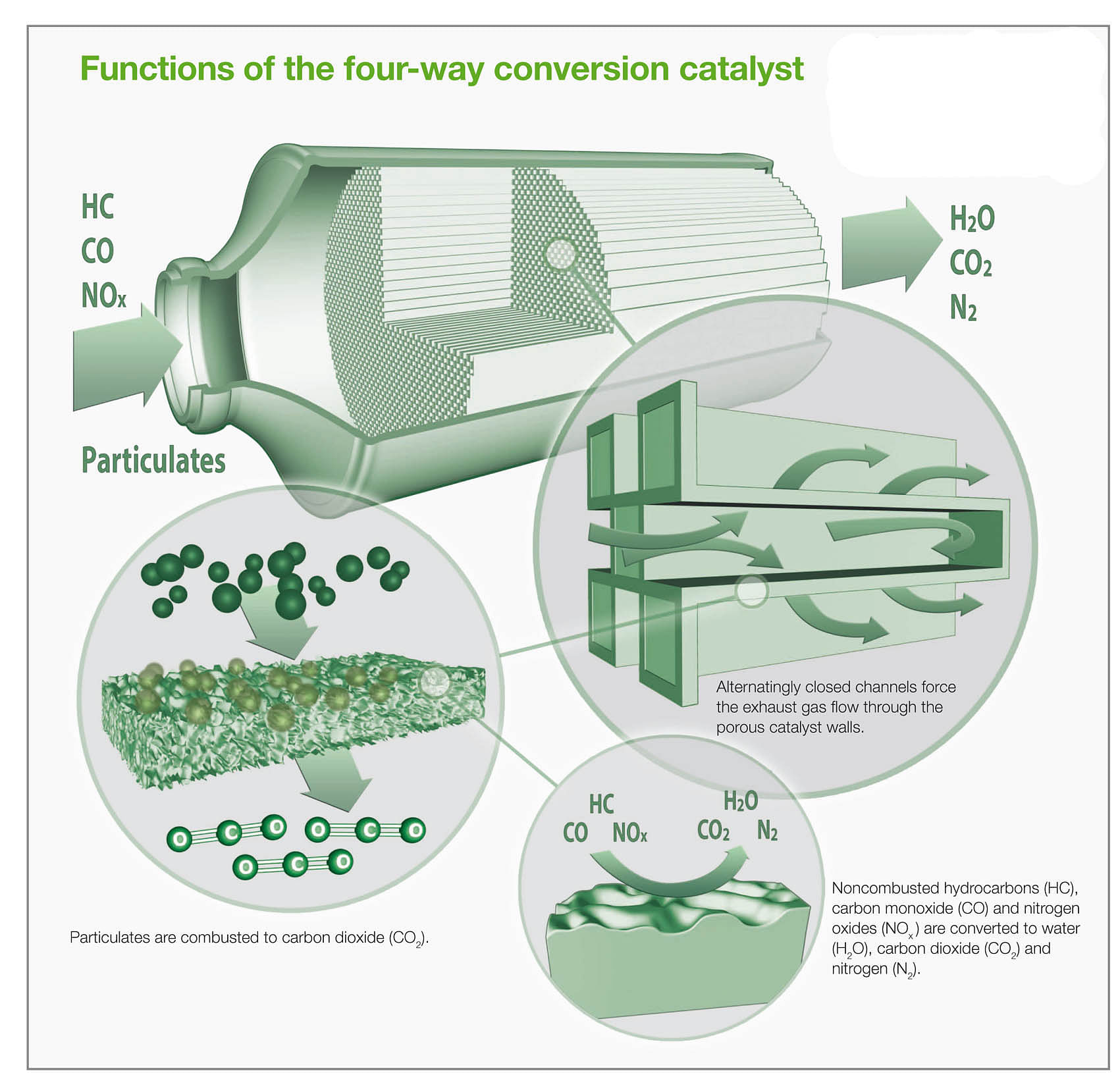BASF develops new 4-way conversion catalyst system for petrol engines
Along with growing prosperity in many emerging markets comes an increasing wish for personal mobility.
Along with growing prosperity in many emerging markets comes an increasing wish for personal mobility. Simultaneously, global urbanisation is increasing vehicle density. LMC Automotive estimates that about a billion cars are currently on the roads around the globe, with this figure likely to reach almost 1.2 billion by the year 2018 – cumulatively impacting the air quality of the world's major cities. Propulsion concepts like electromobility – fully electric or as a hybrid variant – are steadily gaining importance.
“However, the internal combustion engine will remain the dominant propulsion concept on the roads in the medium term,” says Dr. Klaus Harth, responsible for research on automotive catalytic converters at BASF. “Reducing pollutant contamination from internal combustion engines therefore remains an important global issue,” he adds.
Official emission standards are becoming more and more restrictive worldwide. In the future, compliance with these standards will require further optimising of the catalytic converter. BASF says it has a promising new technology for this purpose in the new four-way conversion catalyst. Internal combustion engines produce environmentally harmful emissions because the fuel – a mixture of hydrocarbons – burns incompletely. To prevent pollutants such as nitrogen oxides, carbon monoxide, non-combusted hydrocarbons and particulates from entering the air, petrol and diesel-powered vehicles are equipped with catalytic converters and, in some cases, also with particulate filter systems. They clean the exhaust gas flow before it leaves the exhaust system. This has drastically reduced pollution levels over the last four decades.
The well-known three-way conversion catalyst has been in use in North America since 1976 – and in Europe since 1986. According to Harth, “Catalytic converters are now capable of removing considerably more than 95 percent of the undesired substances from the exhaust gas flow.” This is achieved by the internal structure of the conversion catalysts: exhaust gas catalysts are made of a special ceramic support, the monolith, which contains numerous parallel channels. Depending on their intended use, the channel walls have differently sized pores.
This ceramic support is covered with a washcoat containing metal oxide particles with a very large internal surface. The washcoat contains finely distributed precious metal particles (such as palladium and rhodium in three-way conversion catalysts). These materials are catalytically active and ensure the conversion of carbon monoxide (CO), noncombusted hydrocarbons (HC) and nitrogen oxides (NOx) into water (H2O), nitrogen (N2 and carbon dioxide (CO2). As catalytically active substances, the precious metals enable and participate in the reaction but remain unaffected by it – a fundamental property of catalysts.
Three plus one makes four
BASF researchers have further developed the three-way conversion catalyst and optimised its cleaning effect: the new four-way conversion catalyst, FWC, is a technology for vehicles with petrol engines. The catalyst removes the gaseous pollutants, and also solids like particulates from the exhaust gas flow.

“The compact four-way conversion catalyst now combines all the important properties in a single component. Compared to the three-way conversion catalyst and the downstream uncoated particulate filter, it occupies much less space,” says Harth. Another advantage: “We have succeeded in ensuring that the FWC produces only a slight backpressure to the exhaust gas flow,” explains the BASF expert. This is an important aspect for the automotive manufacturers. A high backpressure increases the resistance the exhaust gas flow has to overcome before it reaches the exhaust system. If the backpressure is too high, this impairs the performance of the engine and lowers fuel efficiency.
To keep the backpressure as low as possible, BASF experts have developed innovative production and coating technologies. These make it possible, for example, to coat the porous inner walls of the monolith specifically with the catalytically active material. The four-way conversion catalyst has a pronounced cleaning effect. “Our many years of experience with catalyst technologies have equipped us to create tailor-made catalytic structures,” adds Harth.
This results in an enormously large surface with catalytic activity. By that, less precious metal is needed in the four-way conversion catalyst. The porous monolith wall also acts as a filter for the particulates, which are retained by the wall and combusted to carbon dioxide at high temperatures and with the aid of the catalytic coating. The four-way catalytic converter from BASF therefore does more than a system with an uncoated filter: Because most of the particulates are combusted to CO2, the pores of the catalyst do not easily clog – ensuring that the components remain functional.
The long-term stability has already been demonstrated in a series of tests: even after more than 160,000 kilometres driven, the four-way conversion catalyst still cleans the exhaust gas effectively achieving stringent emission limits. The system was launched in April 2013 and is now in the development and test phase with numerous automotive manufacturers – always with a view to serial production. “The four-way conversion catalyst helps automotive manufacturers to comply with the strict emission regulations like the Euro 6 standard,” says Harth. “In a few years, our system will be part of the established technology for exhaust emissions cleanup.”
RELATED ARTICLES
Isuzu unveils D-Max EV at 2025 Commercial Vehicle Show
Revealed at the 2025 Commercial Vehicle Show in Birmingham, the Isuzu -Max EV is the first fully electric commercial pic...
Hyundai unveils next−gen highly efficient hybrid system
The next-gen hybrid system is claimed to offer 45% better fuel efficiency and 19% more power compared with ICE powertrai...
Horse Powertrain reveals hybrid conversion for electric cars
Engine-making joint venture of Geely and the Renault Group announces new hybrid powertrain that fits into the same space...






 By Autocar Professional Bureau
By Autocar Professional Bureau
 11 Dec 2014
11 Dec 2014
 12042 Views
12042 Views









